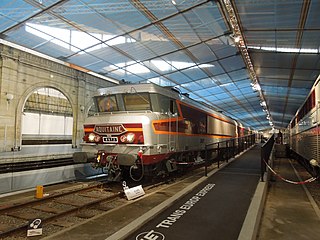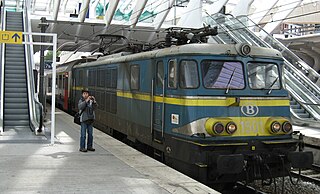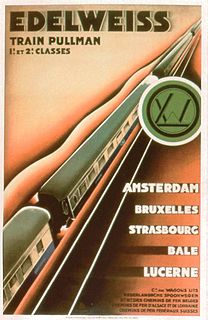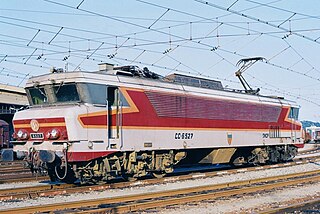 W
WThe Albert Schweitzer was a short-lived express train that linked Dortmund Hbf in Dortmund, Germany, with Strasbourg-Ville in Strasbourg, France. Introduced in 1980, it was operated by the Deutsche Bundesbahn (DB) and the SNCF.
 W
WThe Aquitaine was an express train that linked Bordeaux and Paris, France, between 1971 and about 1990. Operated by the Société Nationale des Chemins de fer français (SNCF), it was a first-class-only Trans Europ Express (TEE) until 1984 and then a two-class Rapide until discontinued, circa 1990.
 W
WThe Arbalète was an express train that linked Paris-Est in Paris, France, with Zürich HB in Zurich, Switzerland. Introduced in 1957, it was operated by the SNCF and the Swiss Federal Railways (SBB-CFF-FFS).
 W
WThe Brabant was an express train that linked Gare du Nord in Paris, France, with Brussels-South in Brussels, Belgium. The train was named after the historical Duchy of Brabant of which Brussels was the capital.
 W
WLe Capitole was an express train between Paris and Toulouse in France. Introduced in 1960, it was operated by the Société Nationale des Chemins de fer français (SNCF). It was also the SNCF’s first foray into high-speed commercial service above 160 km/h (99 mph).
 W
WThe Catalan Talgo was an international express train that linked Geneva, Switzerland, with Barcelona, Spain from 1969 to 2010. It was named after the Spanish region Catalonia and the Talgo equipment it used. It was an extension and upgrading of a predecessor train, Le Catalan, a first-class-only French (SNCF) Rapide train that had been in operation since 1955 but running only between Geneva and the stations nearest the Spanish-French border, connecting with a second-class-only "autorail" trainset to and from Barcelona. The national railway network of Spain, Red Nacional de los Ferrocarriles Españoles (RENFE), was using Iberian gauge for all of its main lines, while those of France and Switzerland use standard gauge. As a result of this break-of-gauge, train journeys between Geneva and Barcelona consisted of two separate parts, with travelers having to change from a French to a Spanish train or vice versa at the border—at Portbou on southbound trains and at Cerbère on northbound trains. In 1968, this was resolved with the introduction of the Talgo III RD trainsets, which featured variable gauge wheelsets. At Portbou station, the wheel spacing of each passenger carriage was adjusted by a gauge changer for the difference in gauge, and passengers no longer had to change trains. After successful test runs, the Catalan was extended from Port Bou to Barcelona as a through train on 1 June 1969, becoming the Catalan Talgo and upgraded to a Trans Europ Express (TEE). Most other rail journeys through this border crossing continued to require a change of train at Cerbère station or at Port Bou, as most trains did not use Talgo III RD trainsets.
 W
WThe Cisalpin was an express train that linked Paris-Gare de Lyon in Paris, France, with Milano Centrale in Milan, Italy. Introduced in 1961, it was operated by the SNCF, the Swiss Federal Railways (SBB-CFF-FFS) and the Italian State Railways (FS).
 W
WThe Edelweiss was an international express train. For most of its existence, it linked the Netherlands with Switzerland, via Belgium, Luxembourg and France. Introduced in 1928, it was named after a mountain flower, the Edelweiss, which is associated with alpinism and the Alps, and regarded as a symbol of Switzerland.
 W
WThe Étendard was an express train that linked Paris and Bordeaux in France. Introduced in 1968, it was operated by the Société Nationale des Chemins de fer français (SNCF), and was initially a Rapide.
 W
WThe Étoile du Nord was an international express train. It linked Paris Nord in Paris, France, with Brussels, Belgium, and, for most of its existence, also with Amsterdam CS in Amsterdam, the Netherlands. Its name meant literally "Star of the North", and alluded not only to its route heading north from Paris, but also to one of its original operators, the Chemin de Fer du Nord.
 W
WThe Goethe was an express train that, for most of its existence, linked Paris-Est in Paris, France, with Frankfurt Hbf in Frankfurt, Germany. Introduced in 1970, it was operated by the SNCF and the Deutsche Bundesbahn / Deutsche Bahn (DB).
 W
WThe Île de France was an international express train on the PBA route (Paris–Brussels–Amsterdam). The train was named after the French region surrounding Paris.
 W
WThe Iris is an express train that links Brussels Midi/Zuid in Brussels, Belgium, with Chur station in Chur, Switzerland.
 W
WThe Jean Monnet was an express train that linked Brussels Midi/Zuid in Brussels, Belgium, with Strasbourg-Ville in Strasbourg, France, and later also with Bâle SNCF in Basel, Switzerland. Introduced in 1999, it was operated by the National Railway Company of Belgium (NMBS/SNCB), the Chemins de Fer Luxembourgeois (CFL), and the French National Railway Corporation (SNCF).
 W
WThe Jules Verne was an express train that linked Paris and Nantes in France. Operated by the Société Nationale des Chemins de fer français (SNCF), it was the last new Trans Europ Express (TEE) to be introduced, in 1980.
 W
WKléber was an express train that linked Strasbourg and Paris, France, between 1971 and 1988. It was a first-class-only Trans Europ Express (TEE) operated by the Société Nationale des Chemins de fer français (SNCF).
 W
WThe Ligure was an international express train operated by the Italian Railways linking Milan with the Côte d'Azur. The train was named after the Italian region Liguria which was served by the train.
 W
WLe Lyonnais, or the Lyonnais, was an express train that linked Paris and Lyon in France. Introduced in 1968, it was operated by the Société Nationale des Chemins de fer français (SNCF). The train is named after the geographical area known as the Lyonnais, a historical (former) French province, whose name came from the city of Lyon.
 W
WLe Mistral, or the Mistral, was an express train between Paris and Nice in France. Introduced in 1950, it was operated by the Société Nationale des Chemins de fer français (SNCF), and was regarded as the company's flagship train.
 W
WThe Molière was an international train operated by SNCF, initially linking Paris and Düsseldorf. The train was named after Jean Baptiste Poquelin, using his stage name.
 W
WThe Mont Cenis was an international express train linking Lyon in France with Milan in Italy. The train was named after the mountain range through which it crossed, inside the Fréjus Rail Tunnel on the French-Italian border.
 W
WL'Oiseau Bleu was an international express train linking Antwerp with Paris. The train was named after the play L'Oiseau Bleu as a tribute to its author, the Belgian Nobel prize laureate Maurice Maeterlinck.
 W
WThe Paris–Ruhr was an express train that linked Paris in France, with Dortmund in Germany. The train was named after its two termini, Paris in the west and the Ruhr district in the east. For most of its life, it was a Trans Europ Express (TEE).
 W
WThe Parsifal was an express train that linked Paris with Dortmund in Germany and later Cologne. The train was named after Wagner's opera inspired by the legendary knight Percival.
 W
WLe Rhodanien, or the Rhodanien, was an express train with its southern terminus in Marseilles, France. Operated by the Société Nationale des Chemins de fer français (SNCF), it was named using the French language adjective derived from the Rhone river; the name alludes, amongst other things, to the river, its valley, and the dialect of the Franco-Provençal language that is spoken there.
 W
WThe Silver Arrow was an intermodal passenger transport service linking Victoria station in London with Gare du Nord in Paris, via Gatwick Airport and Le Touquet Airport, northern France. In operation between 1956 and the opening of the Channel Tunnel, it used a combination of rail and air transport, and, for some of its existence, also buses.
 W
WStanislas was an express train that linked Paris and Strasbourg in France. Introduced in 1971, it was operated by the Société Nationale des Chemins de fer français (SNCF).
 W
WSud Express is an overnight passenger train connecting Lisbon with Hendaye, a French commune on the Franco-Spanish border. The original service, operated by the Compagnie Internationale des Wagons-Lits, ran to Calais via Madrid and Paris.
 W
WThe Vauban was an express train that linked Brussels Midi/Zuid in Brussels, Belgium, with France, Switzerland and Italy. Introduced in 1988, it was operated by the National Railway Company of Belgium (NMBS/SNCB), the Chemins de Fer Luxembourgeois (CFL), the SNCF, the Swiss Federal Railways (SBB-CFF-FFS), and the Italian State Railways (FS).
 W
WThe Venice Simplon-Orient-Express (VSOE) is a private luxury train service from London to Venice and other European cities. It is currently owned by Belmond, which operates 45 luxury hotels, restaurants, tourist trains and river cruises in 24 countries. It was agreed in December 2018 for the service to be acquired by LVMH in a transaction initially expected to close in the first half of 2019.
 W
WThe Watteau was an express train that linked Gare du Nord in Paris, France, with Tourcoing in the North of France. The train was named after the French painter Antoine Watteau.